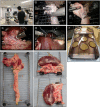Development and validation of a porcine organ model for training in essential laparoscopic surgical skills
- PMID: 32743896
- PMCID: PMC7589398
- DOI: 10.1111/iju.14315
Development and validation of a porcine organ model for training in essential laparoscopic surgical skills
Abstract
Objectives: To develop a wet laboratory training model for learning core laparoscopic surgical skills and evaluating learners' competency level outside the operating room.
Methods: Participants completed three tasks (task 1: tissue dissection around the aorta; task 2: tissue dissection and division of the renal artery; task 3: renal parenchymal closure). Each performance was video recorded and subsequently evaluated by two experts, according to the Global Operative Assessment of Laparoscopic Skills and task-specific metrics that we developed (Assessment Sheet of Laparoscopic Skills in Wet Lab score). Mean scores were used for analyses. The subjective mental workload was also assessed (NASA Task Load Index).
Results: The 54 participants included 32 urologists, eight young trainees and 14 medical students. A total of 13 participants were categorized as experts (≥50 laparoscopic surgeries), eight as intermediates (10-49) and 33 as novices (0-9). There were significant differences in the Global Operative Assessment of Laparoscopic Skills and Assessment Sheet of Laparoscopic Skills in Wet Lab scores among the three groups in all three tasks. Higher NASA Task Load Index scores were observed in novices, and there were significant differences in tasks 1 (Kruskal-Wallis test, P = 0.0004) and 2 (P = 0.0002), and marginal differences in task 3 (P = 0.0745) among the three groups.
Conclusions: Our training model has good construct validity, and differences in the NASA Task Load Index score reflect previous laparoscopic surgical experiences. Our findings show the ability to assess both laparoscopic surgical skills and mental workloads, which could help educators comprehend trainees' level outside the operating room. Given the decreasing opportunity to carry out pure laparoscopic surgeries because of the dissemination of robotic surgery, especially in urology, our model can offer practical training opportunities.
Keywords: animal organs; laparoscopic surgery; simulation; surgical education; wet lab training.
© 2020 The Authors. International Journal of Urology published by John Wiley & Sons Australia, Ltd on behalf of the Japanese Urological Association.
Conflict of interest statement
None declared.
Figures







References
-
- Lee GC, Bordeianou LG, Francone TD et al Superior pathologic and clinical outcomes after minimally invasive rectal cancer resection, compared to open resection. Surg. Endosc. 2020; 34: 3435–48. - PubMed
-
- Gao Y, Xi H, Qiao Z et al Comparison of robotic‐ and laparoscopic‐assisted gastrectomy in advanced gastric cancer: updated short‐ and long‐term results. Surg. Endosc. 2019; 33: 528–34. - PubMed
-
- Piedimonte S, Czuzoj‐Shulman N, Gotlieb W, Abenhaim HA. Robotic radical hysterectomy for cervical cancer: a population‐based study of adoption and immediate postoperative outcomes in the United States. J. Minim Invasive Gynecol. 2019; 26: 551–7. - PubMed
Publication types
MeSH terms
Grants and funding
LinkOut - more resources
Full Text Sources
Miscellaneous

